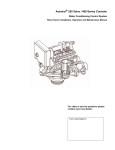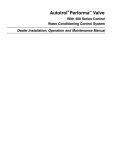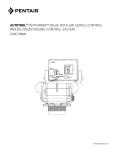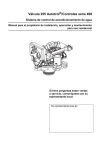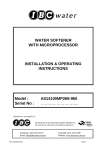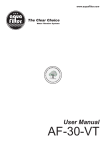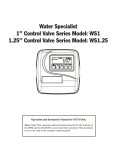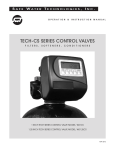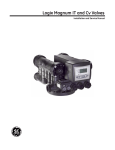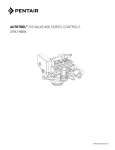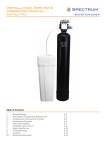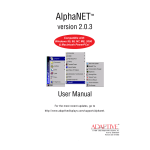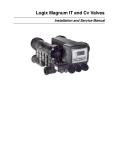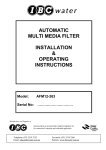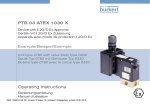Download Performa FA Filter Owners Manual 1230232
Transcript
Autotrol® Performa™ FA Valve With 400 Series Control Water Conditioning Control System Dealer Installation, Operation, and Maintenance Manual Table of Contents Installation . . . . . . . . . . . . . . . . . . . . . . . . . . . . . . . . 3 Location Selection Water Line Connection Drain Line Connection Regenerant Line Connection Overflow Line Connection Placing Conditioner into Operation . . . . . . . . . . . . . 5 Electrical Connection 440i Control Settings . . . . . . . . . . . . . . . . . . . . . . . . 6 Programming Manual Regeneration Removing the Valve Assembly for Servicing . . . . . . 7 Removing 440i or 460i for Servicing . . . . . . . . . . . . 7 Preventive Maintenance . . . . . . . . . . . . . . . . . . . . . 8 Injector Screen and Injector Specifications . . . . . . . . . . . . . . . . . . . . . . . . . . . . . 9 Pressure Graphs . . . . . . . . . . . . . . . . . . . . . . . . . . 10 Identification of Control Valving . . . . . . . . . . . . . . . 11 Valve Disc Principle of Operation . . . . . . . . . . . . . 11 Flow Diagrams. . . . . . . . . . . . . . . . . . . . . . . . . . . . 12 1 Service Position 2 Backwash Position 3 Draw/Slow Rinse Position 4 Fast Rinse/Refill Position Replacement Parts . . . . . . . . . . . . . . . . . . . . . . . . 13 Performa Valve 440i Control 1265 Bypass Troubleshooting . . . . . . . . . . . . . . . . . . . . . . . . . . . 15 2 Installation All plumbing and electrical connections must conform to local codes. Inspect the unit carefully for carrier shortage or shipping damage. In Not in Bypass Out In Bypass Out In Location Selection BY PA S S BY PA S S BY BY 1. The distance between the unit and a drain should be as short as possible. PA S S PA S S 2. If it is likely that supplementary water treatment equipment will be required. Make sure adequate additional space is available. 3. Since salt must be added periodically to the brine tank, the location must be easily accessible. Water Conditioner 4. There should be at least 10 feet (3 m) of piping between the outlet of the conditioner and the inlet to the heater. Water heaters can sometimes overheat and transmit heat back down the cold pipe into the unit control valve. Water Conditioner Figure 1 - Autotrol Series 1265 Bypass Valve Hot water can severely damage the conditioner. A 10-foot (3-m) total pipe run, including bends, elbows, etc., is a reasonable distance to help prevent this from happening.To prevent hot water flowing from heat source to the conditioner, in the event of a negative pressure situation, install a check valve in the treated water piping from the conditioner. If a check valve is installed, make sure the water heating unit is equipped with a properly rated temperature and pressure safety relief valve. Also, make sure that local codes are not violated. Not in Bypass In Bypass Water Conditioner Water Conditioner Water Water Figure 2 - Typical Globe Valve Bypass System Drain Line Connection 5. Do not locate the unit where it or its connections (including the drain and overflow lines) will ever be subjected to room temperatures under 34oF (1oC) or over 120oF (49oC). Note: Standard commercial practices are followed here. Local codes may require changes to the following suggestions. 1. Ideally located, the unit is above and not more than 20 feet (6.1 m) from the drain. For such installations, using an appropriate adapter fitting, connect 1/2-inch (1.3-cm) plastic tubing to the drain line connection of the control valve. 6. Do not install the unit near acid or acid fumes. 7. The use of resin cleaners in an unvented enclosure is not recommended. Water Line Connection 2. If the backwash flow rate exceeds 5 gpm (22.7 Lpm) or if the unit is located more than 20 feet (6.1 m) from the drain, use 3/4-inch (1.9-cm) tubing for runs up to 40 feet (12.2 m). Also, purchase the appropriate fitting to connect the 3/4-inch tubing to the 3/4-inch NPT drain connection. The installation of a bypass valve system is recommended to provide for occasions when the water conditioner must be bypassed for untreated water or for servicing. The most common bypass systems are the Autotrol Series 1265 bypass valve (Figure 1) and the plumbedin globe valves (Figure 2). Though both are similar in function, the Autotrol Series 1265 bypass offers simplicity and ease of operation. 3. If the unit is located where the drain line must be elevated, you may elevate the line up to 6 feet (1.8 m) providing the run does not exceed 15 feet (4.6 m), and the water pressure at conditioner is not less than 40 PSI (2.76 bar). You may elevate an additional 2 feet (61 cm) for each additional 10 PSI (0.69 bar). 3 Overflow Line Connection 4. Where the drain line is elevated but empties into the drain below the level of the control valve, form a 7-inch (18-cm) loop at the far end of the line so that the bottom of the loop is level with the drain line connection. This provides an adequate siphon trap. In the absence of a safety overflow and in the event of a malfunction, the REGENERANT TANK OVERFLOW directs “overflow” to the drain instead of spilling the “overflow” on the floor where it could cause considerable damage. This fitting must be on the side of the cabinet or regenerant tank. Note: Where the drain empties into an overhead sewer line, a sink-type trap must be used. To connect the overflow line, locate the hole on the side of the regenerant tank. Insert the overflow fitting (not supplied) into the tank and tighten the fitting with plastic thumb nut and gasket as shown (Figure 4). Attach a 1/2-inch (1.3-cm) length of I.D. tubing (not supplied) to the fitting, and run it to the drain. Do not elevate the overflow line higher than 3 inches (7.6 cm) below the bottom of the overflow fitting. Do not connect to the drain line of control unit. The overflow line must be a direct, separate line from the overflow fitting to the drain, sewer, or tub. Allow an air gap as per drain line instructions (Figure 3). IMPORTANT: Never insert the drain line into a drain, sewer line, or trap. Always allow an air gap between the drain line and the wastewater to prevent the sewage from back-siphoning into the conditioner (Figure 3). Right Way Figure 3 Note: Standard commercial practices have been followed here. Local codes may require changes to these suggestions. Overflow Fitting Installed Regenerant Tank Regenerant Line Connection It is necessary to connect the regenerant line to the fitting on the valve (3/8-inch NPT). Connect 1/2-inch (1.3-cm) Tubing or Hose and Run to Drain Make sure all fittings and connections are tight. Figure 4 4 Placing Conditioner into Operation carefully advance the indicator knob COUNTERCLOCKWISE to the center of the REFILL position. Hold the indicator knob at this position until water starts to flow through the regenerant line into the regenerant tank. Do not run the unit for more than one or two minutes. B. Advance the indicator knob COUNTERCLOCKWISE until it points to the center of the DRAW/SLOW RINSE position. C. With the indicator knob in this position, check to see if water is being drawn from the regenerant tank. The water level in the regenerant tank recedes very slowly. Observe the water level for at least three minutes. If the water level does not recede, or if it goes up, reference the Troubleshooting section. D. Advance the indicator knob COUNTERCLOCKWISE to the SERVICE or CONDITIONED WATER position and run water from a nearby faucet until the water is clear and soft. After all of the previous steps have been completed, the unit is ready to be placed into operation. Follow these steps carefully. 1. Remove the control valve cover by first releasing the plastic tab from the back of the cover. Pull the back of the cover slightly outward and lift it up. Note: The following steps will require turning the indicator knob (Figure 5) to various positions. Manually rotate the camshaft COUNTERCLOCKWISE only until the indicator knob points to required position. (See the manual regeneration sections for each control’s manual operation.) 2. Rotate the indicator knob COUNTERCLOCKWISE until it points directly to the word BACKWASH. 3. Fill the media tank with water. A. With the water supply off, place the bypass valve(s) into the “not in bypass” position. B. Open the water supply valve very slowly to approximately the 1/4 open position. 6. Add the regenerant. Potassium permanganate is normally used as the regenerant, however, other regenerants that provide satisfactory results may be used. IMPORTANT: If the water supply valve is opened too rapidly or too far, media may be lost. In the 1/4 open position, you will hear air escaping slowly from the drain line. Electrical Connection C. When all of the air has been purged from the tank (water begins to flow steadily from the drain), open the main supply valve all of the way. D. Allow the water to run to the drain until it is clear. E. Turn off the water supply and let the unit stand for about five minutes. This allows all of the trapped air to escape from the tank. 100 VAC, 115 VAC, and 230 VAC units: Remove the twist tie from the power cord, and extend the cord to its full length. Make sure the power source matches the rating printed on the control. Make sure a wall switch does not control the outlet. 12 VAC: Connect the plug of the transformer (supplied) secondary cable to the mating socket at the rear or bottom of the timer housing. Make sure the transformer is secure and is plugged into a power source of correct voltage that is not controlled by a wall switch. 4. Add water to the regenerant tank (initial fill). With a bucket or hose, add water to the regenerant tank. If the tank has a platform above the bottom of the tank, add water until the level is approximately 1 inch (25 mm) above the platform. Do not add regenerant at this time. 5. Place the unit into operation. A. With the water supply valve completely open, 5 440i Control Settings Manual Regeneration Day Arrow Electricity is used only to run the control and to rotate the camshaft. All other functions are operated by water pressure. Therefore, in the event of a power outage, all the regeneration positions may be dialed manually by depressing the indicator knob and turning COUNTERCLOCKWISE (Figure 5). The following cycle times should be used for proper regeneration: Skipper Wheel Skipper Pins BACKWASH—20 minutes DRAW/SLOW RINSE—50 minutes FAST RINSE/REFILL—10 minutes DRAW Do not exceed 10 minutes for the FAST RINSE/REFILL cycle as this causes excessive regenerant usage during the next regeneration and possibly a regenerant residue in the treated water. Indicator Knob Timer Locking Pin Time Arrow Timer Knob Figure 5 Programming 1. Set the number of days of regeneration on the skipper wheel (Figure 5). • Pull all of the skipper pins outward (away from the control). • Rotate the skipper wheel until day arrow points to the number of current day or number 1. • Depress the skipper pin(s) at the day(s) for which regeneration is required. 2. Set the time of day. • Grasp the timer knob and pull it outward. • Rotate it in either direction until the timer arrow points to the actual time of day. • Release the timer knob. Note: With the time of day properly set, the conditioner regenerates at about 2:30 a.m. If you prefer to have the unit regenerate at an earlier or later time, simply set the current time-of-day accordingly (e.g., to have the unit regenerate at 4:30 a.m.—two hours later—set the clock two hours earlier than the actual time of day.) Note: The Timer Locking Pin should always be horizontal (Figure 5) during operation. 6 Removing the Valve Assembly for Servicing 1. Unplug the power cord. 2. Shut off the water supply or put the bypass valve(s) into bypass position. Lever Down 3. Remove the cover, and with a screwdriver, relieve tank pressure by pushing open valve No. 7 (rear flapper) on the control as shown (Figure 10). Figure 11 Lever Up Figure 10 4. When used with a globe valve bypass, loosen and detach the inlet, outlet, regenerant, and drain lines from the valve. If using the 1265 bypass, loosen and remove the valve from bypass as well as loosening and removing the regenerant and drain lines. 5. Unscrew the valve (counterclockwise) and remove the valve from tank. Cam Pulled Out Figure 12 6. To replace the control valve, reverse the above procedure. 6. Remove the timer locking pin and lift the control straight up and off of the valve. Removing 440i or 460i for Servicing 1. Unplug the power cord. 7. To reinstall the camshaft and control, reverse the above procedures. 2. Remove cover. Note: When reinstalling the camshaft the control should be in SERVICE position. When the camshaft is positioned, cams will make contact with valves to force them open. 3. The control should be in service position (Figure 11). 4. Rotate the locking lever to point up (Figure 12). 5. Pull the end of the camshaft out from the lever and remove the camshaft. 7 Preventive Maintenance Injector Screen and Injector 1. Unplug the wall-mount transformer. IMPORTANT: Do not overtighten the plastic cap. Seat the cap lightly into position. Overtightening may cause breakage of the plastic cap that may not be immediately visible. 2. Shut off the water supply or put the bypass valve(s) into the bypass position. 11. Plug the wall-mount transformer into the outlet. Reset the clock, if necessary. 3. Relieve system pressure by opening valve No. 7 (at rear) with a screwdriver (Figure 10). 12. Slowly open the water supply valve or return the bypass valve(s) to the “service” position. Clean the injector screen and the injector once a year: 4. Remove the injector screen and injector cap (Figure 12) with a screwdriver. 5. Clean the injector screen using a fine brush. Flush it with water until clean. Injector Screen 6. Pull the injector straight out using a needle-nose pliers. 7. Flush water into the injector screen recess of the valve body to flush debris out through the injector recess. Turbine 8. Clean and flush the injector with water. 9. Lubricate the O-rings on the injector, injector cap, and injector screen with silicone lubricant only! Injector 10. Reinstall the injector, injector cap, and injector screen. Figure 13 8 Cap Specifications Hydrostatic Test Pressure . . . . . . . . . . . . . . . . . . . . . . . . . . . . . . . . . . . . . . . . . . . . . . . . . . . . . . . . 300 PSI (20.69 bar) Working Pressure. . . . . . . . . . . . . . . . . . . . . . . . . . . . . . . . . . . . . . . . . . . . . . . . . . . . . . . . 20-125 PSI (1.38 - 8.62 bar) Standard Electrical Rating . . . . . . . . . . . . . . . . . . . . . . . . . . . . . . . . . . . . . . . . . . . . . . . . . . . . . . . . . . . . . . . 12V 60 Hz Optional Electrical Rating . . . . . . . . . . . . . . . . . . . . . . 115V 50 Hz, 230V 50 Hz, 200V 60 Hz, 24V 60 Hz, 24V 50 Hz, 100V 60 Hz, 100V 50 Hz, 12V 50 Hz/transformer, 12V 60 Hz/transformer Pressure Tank Thread . . . . . . . . . . . . . . . . . . . . . . . . . . . . . . . . . . . . . . . . . . . . . . . . . . . . . . . . . . . . 2 1/2 inch-8 male Riser Pipe Diameter Required . . . . . . . . . . . . . . . . . . . . . . . . . . . . . . . . . . . . . . . . . . . . . . . . 1.050 inch OD (26.7 mm) Riser Pipe Length . . . . . . . . . . . . . . . . . . . . . . . . . . 1-1/8 ±1/8 inches (31.8 mm) higher than the top of mineral tank Standard Connection . . . . . . . . . . . . . . . . . . . . . . . . . . . . . . . . . . . . . . . . . . .1-inch (25.4-mm) copper tube adapters Optional Connections . . . . . . . . . . . . . . . . . . . . . . . 3/4-inch, 1-1/4-inch, 22-mm, and 28-mm copper tube adapters 3/4-inch BSPT, 1-inch BSPT, 1-inch NPT brass pipe adapters 3/4-inch, 1-inch, 25-mm CPVC tube adapters Regenerant Line Connection . . . . . . . . . . . . . . . . . . . . . . . . . . . . . . . . . . . . . . . . . . . . . . . . . . . . . . 3/8-inch NPT male Drain Line Connection . . . . . . . . . . . . . . . . . . . . . . . . . . . . . . . . . . . . . . . . . . . . . . . . . . . . . . . . . . . 3/4-inch NPT male Optional Bypass Valve. . . . . . . . . . . . . . . . . . . . . . . . . . . . . . . Rotating handles, full 1-inch porting, reinforced Noryl* Control Module, Tank Adapter. . . . . . . . . . . . . . . . . . . . . . . . . . . . . . . . . . . . . . . . . . . . . . . . . . . . . . . Reinforced Noryl Rubber Goods . . . . . . . . . . . . . . . . . . . . . . . . . . . . . . . . . . . . . . . . . . . . . . . . . . Compounded for cold water service Program Clock (Timer). . . . . . . . . 440i: Available in 6- or 7-day English, German, French, Italian, Spanish, Japanese Injector Size “A” White . . . . . . . . . . . . . . . .Nozzle 042-inch (1.1-mm) diameter, Throat .089-inch (2.3-mm) diameter Injector Size “B” Blue . . . . . . . . . . . . . . . . Nozzle .052-inch (1.3-mm) diameter, Throat .099-inch (2.5-mm) diameter Injector Size “C” Red. . . . . . . . . . . . . . . . . Nozzle .059-inch (1.5-mm) diameter, Throat .099-inch (2.5-mm) diameter Injector Size "D" Green . . . . . . . . . . . . . . . Nozzle .071-inch (1.8-mm) diameter, Throat .147-inch (3.7-mm) diameter Internal Backwash Controllers. . . . . . . . . . . . . . . . 7- through 14-inch (17.8- though 35.6-cm) diameter media tanks All sizes to flow 5.0 gpm/sq ft (183 L/m/m2) of bed area. For tank sizes above 14 inches in diameter, use an external flow control. * Noryl is a trademark of the General Electric Company. 9 Pressure Graphs Injector #1031363 Injector #1031364 "A" in a 268 Valve "B" in a 268 Valve 1.00 0.30 0.20 Total 1.25 0.25 0.75 1.00 0.20 Rinse Rinse 0.50 Regenerant Draw 0.05 0.00 0.15 0.75 GPM M3/hr 0.10 GPM M3/hr 0.15 Total 0.10 0.50 0.05 0.25 0.00 0.00 Regenerant Draw 0.25 0.00 20 40 400 600 60 PSI 80 100 120 20 800 1000 1200 1400 1600 1800 bar 40 400 600 60 Rinse 0.20 0.10 0.05 M3/hr 1.00 GPM M3/hr 0.25 Total 0.75 0.10 Regenerant Draw 0.50 0.05 0.25 0.00 0.15 0.00 0.00 20 40 400 600 60 PSI 80 100 2.25 2.00 1.75 1.50 1.25 1.00 0.75 0.50 0.25 0.00 Total Rinse GPM 0.30 1.25 120 "D" in a 268 Valve 1.75 0.15 100 800 1000 1200 1400 1600 1800 bar "C" in a 268 Valve 1.50 80 Injector #1030272 Injector #1031365 0.20 PSI Regenerant Draw 20 120 40 400 600 800 1000 1200 1400 1600 1800 bar 60 PSI 80 7 8 9 10 12 13 14 Flow (GPM*) 1.3 1.7 2.2 2.7 3.4 4.5 5.3 Flow (LPM*) 4.9 6.4 8.3 10.2 12.9 17.0 20.0 10 120 800 1000 1200 1400 1600 1800 bar Backwash Number *Approximate flow rates at 60 PSI (4.14 bar) 100 Control Valve Identification of Control Valving Valve Disc Principle of Operation 6 Rinse Drain Valve 7 Backwash Drain Valves 4 Outlet Valve 2 Bypass Valve 5 Refill Valve 1 Brine Valve 3 Inlet Valve 11 Flow Diagrams 1 Service Position 2 Backwash Position Hard Water Hard Water Soft Water Soft Water Inlet Inlet 3 3 2 2 5 5 Outlet Outlet 4 6 4 Drain Mineral Tank Regenerant Tank Regenerant Tank 4 Fast Rinse/Refill Position 3 Draw/Slow Rinse Position Hard Water Hard Water Soft Water Soft Water 1 Mineral Tank Regenerant Adjustment 1 Mineral Tank Inlet 3 2 5 4 Regenerant Adjustment Inlet 3 2 Outlet Backwash Flow Control Drain Valve No. 1 - Closed 2 - Open 3 - Closed 4 - Open 5 - Closed 6 - Closed 7 - Open Mineral Tank 7 6 7 Valve No. 1 - Closed 2 - Closed 3 - Open 4 - Open 5 - Closed 6 - Closed 7 - Closed 5 6 Outlet 7 Drain Valve No. 1 - Open 2 - Open 3 - Closed 4 - Closed 5 - Closed 6 - Open 7 - Closed Regenerant Adjustment 1 Regenerant Adjustment 1 Valve No. 1 - Closed 2 - Open 3 - Open 4 - Closed 5 - Closed 6 - Open 7 - Closed Mineral Tank Regenerant Tank 4 6 Drain Mineral Tank 12 7 Regenerant Tank Replacement Parts Performa Valve 4 5 13 2 13 15 14 9 10 3 1 6 7 12 8 11 * Not Shown Part Code Part Qty. Code 1 1035606 No. Valve Assembly, w/o Flow Controls 1 8 1033441 Refill Cap 1 2 1030376 Camshaft, 440i 1 9 1002449 Drain Fitting Elbow (3/4” hose barbed) 1 3 1031391 Timer Locking Pin 1 10 1000226 Screen/Cap Assembly 1 Drain Control Assembly: 1 11 1010429 O-Ring 1 1035622 Tank Ring 1 Plumbing Adapter Kits: 1 4 5 Description No. Description 1000209 No. 7 (1.2 gpm; 4.5 Lpm) 12 1000210 No. 8 (1.6 gpm; 6.1 Lpm) 13 1000211 No. 9 (2.0 gpm; 7.6 Lpm) 1001606 3/4-inch Copper Tube Adapter Kit 1000212 No. 10 (2.5 gpm; 9.5 Lpm) 1001670 1-inch Copper Tube Adapter Kit 1000213 No. 12 (3.5 gpm; 13.2 Lpm) 1041210 1-1/4-inch Copper Tube Adapter Kit 1000214 No. 13 (4.1 gpm; 15.5 Lpm) 1001608 22-mm Copper Tube Adapter Kit 1000215 No. 14 (4.8 gpm; 18.2 Lpm) 1001609 28-mm Copper Tube Adapter Kit 1030502 Ball, Flow Control 1 1001613 3/4-inch CPVC Tube Adapter Kit Injector Assembly: 1 1032970 “A” Injector - White 6 1001614 1-inch CPVC Tube Adapter Kit 1001615 25-mm CPVC Tube Adapter Kit 1032971 “B” Injector - Blue 1001769 3/4-inch NPT Plastic Pipe Adapter Kit 1032972 “C” Injector - Red 1001603 1-inch NPT Plastic Pipe Adapter Kit 1030272 “D” Injector - Green 1001604 3/4-inch BSPT Plastic Pipe Adapter Kit 7 Injector Cap Assembly: 1 1001605 1-inch BSPT Plastic Pipe Adapter Kit 1000217 “A” Cap 3023824 3/4-inch BSPT S.S Pipe Adapter Kit 1000218 “B” Cap 3023828 1-inch NPT S.S Pipe Adapter Kit 1000219 “C” Cap 3023807 1-inch BSPT S.S Pipe Adapter Kit 1030303 “D” Cap 14 1235339 * * 15 13 Spring, One Piece, 268 Qty. 1 Valve Disc Kit: 1041174 Standard 1041175 Severe Service 3019870 3019874 I-Lid Cover Lever, Locking Cam 268 1 1 440i Control DRAW 1 1265 Bypass Part B Y PA S S Code No. B Y PA S S Description 440i Control (6 day or 7 day) 1 Qty. 1 2 1040930 1265 Bypass 1 * 1000811 Transformer (440i, 460i): 1000907 Transformer Extension Cord 1 * 1 15 feet (4.6 m) 2 * 1034264 Y-Splitter (run 2 units from 1 transformer) * Not Shown 14 1 Troubleshooting The technology upon which the Autotrol Performa control valve is based is well established and proven in service over many years. However, should a problem or question arise regarding the operation of the system, the control can very easily be serviced. For parts mentioned, refer to exploded views in the Replacement Parts section of this manual. IMPORTANT: Service procedures that require the water pressure to be removed from the system are marked with a ! after the possible cause. To remove water pressure from the system, put the bypass valve or three-valve bypass into the bypass position and open the backwash drain valve (the seventh valve back from the control) with a screwdriver. Restore system water pressure when the service work is completed. Valve Troubleshooting Problem 1. Control will not draw. Possible Cause a. Solution Low water pressure. a. Set pump to maintain 30 PSI at unit. b. Restricted drain line. b. Remove restriction. c. Injector plugged ! d. Injector defective ! c. Clean injector and screen. d. Replace injector. e. Valve (2 and/or 4) not closed. e. Remove foreign matter from disc and check disc for closing by pushing in on stem. Replace if needed. a. Regenerant valve (1) being held open. a. Manually operate valve stem to flush away obstruction. b. Remove variable regenerant controller to clean. c. Flush out foreign matter by holding disc open and manually operating valve stem. d. Air leak in regenerant line. d. Check all connections in regenerant line for leaks. 3. System using more or less regenerant than regenerant control is set for. a. a. Correct setting. b. Remove variable regenerant controller and flush out foreign matter. Manually position control to regenerant draw to clean controller (after so doing, position control to “purge” to remove regenerant from tank). c. Defective controller. c. Replace controller. 4. Intermittent or irregular draw. a. Low water pressure. a. Set pump to maintain 30 PSI at unit. b. Defective injector ! b. Replace both injector and injector cap. 5. No conditioned water after regeneration. a. a. Check for power. b. Add chemical. Clean injector. Flush with water. 2. Regenerant tank overflow. b. Uncontrolled regenerant refill flow rate c. ! Valve (3 or 4) not closed during regenerant draw causing refill. Inaccurate setting. b. Foreign matter in controller causing incorrect flow rates ! Unit did not regenerate. b. No chemical in regenerant tank. c. Plugged injector ! c. 6. Control backwashes at excessively low or high rate. a. Incorrect backwash controller used. a. Replace with correct size controller. b. Foreign matter affecting controller operation ! b. Remove controller and ball. Flush with water. 7. Flowing or dripping water at drain or regenerant line after regeneration. a. a. Manually operate valve stem to flush away obstruction. b. Valve stem return spring on top plate weak. b. Replace spring. 8. Unconditioned water leakage during service. a. a. Repeat regeneration making certain that the correct regenerant dosage is set. b. Leaking of bypass valve ! b. Replace O-ring. c. c. Replace O-ring. Drain valve (5 or 6) or regenerant valve (1) held open by foreign matter or particle. Improper regeneration. O-ring around riser tube damaged ! 15 440i Control Troubleshooting Problem 1. Control does not regenerate automatically. 2. Control regenerates at wrong time of day. Possible Cause a. Transformer or motor not connected. Solution a. Connect power. b. Defective timer motor. b. Replace motor. c. c. Depress pins for days regeneration required. d. Binding in gear train of timer. d. Replace timer. a. a. Correct time setting according to instructions. Skipper pins not down on timer skipper wheel. Time set incorrectly. © 2008 Pentair Residential Filtration, LLC P/N 1230232 Rev. C JA09
















